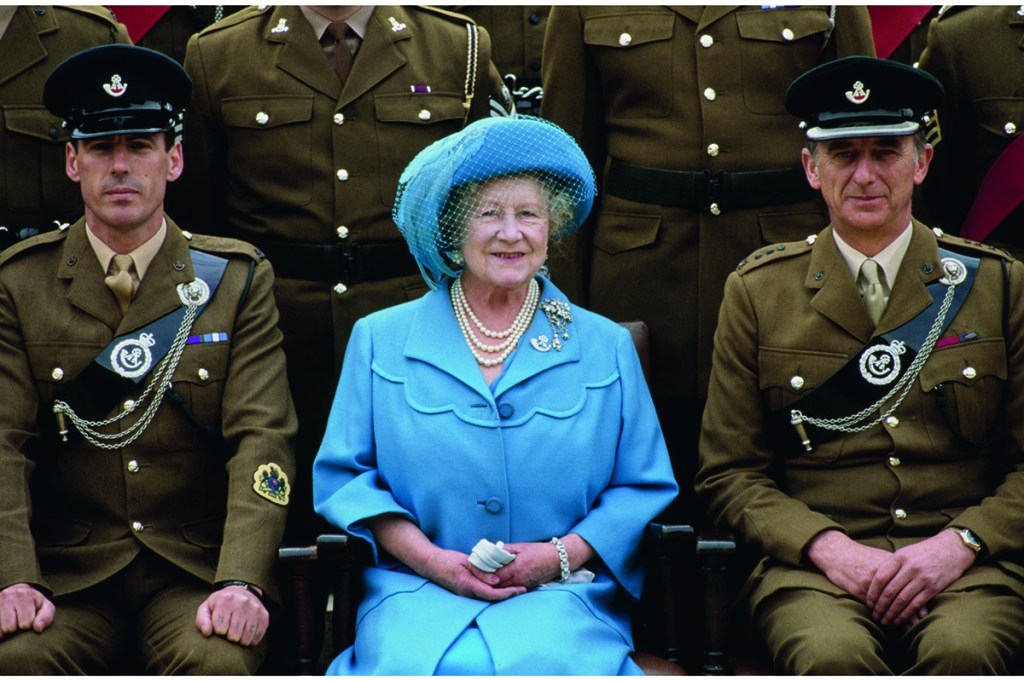Was the Queen Mother ever really funny? She was clearly extremely good company: an attentive listener, full of enthusiasm and affection, right up until her death, aged 101, in 2002. She was also the ideal queen for an unconfident George VI, undermined by his stutter and caught unawares by his accession to the throne, thanks to the abdication of his appallingly selfish brother, Edward VIII.
The only time I ever saw the Queen Mother — when she was eighty, at her Clarence House home — I was only eight, but I remember her clearly. A tiny figure, she beamed away, spreading goodwill among strangers when so many people that age have lost mobility, let alone the ability to cheer up other people.
Grumpy George V had thought much the same of her charm nearly sixty years earlier. He said to his son — her husband — “The better I know and the more I see of your dear little wife, the more charming I think she is and everyone falls in love with her.” But was she ever funny in the way that, say, Larry David is funny? On the basis of this dreadfully written book, the answer is no.
The only really funny line in the book is also her most famous joke. When her footman, William “Backstairs Billy” Tallon, was rowing with his colleague and on-off boyfriend, Reg Wilcock, the Queen Mother came down the stairs and asked, “Would one of you old queens mind getting this old queen a drink?”
There were undoubtedly other times that the Queen Mother was quick and witty — but not funny at the highest level.
Many of her lines are pretty good but depend for their comic power on her status. Take her clever line on liking helicopters: “The chopper has made more difference to my life than it has to any queen’s since dear old Anne Boleyn’s.” If a stand-up comedian said it, it wouldn’t get many laughs.
The Queen Mother was clearly quick-witted. A Boer War veteran once met her in South Africa and said he could never forgive the English for what they had done to the Boers. “I understand perfectly,” she said with fine diplomatic wit. “We feel very much the same in Scotland, too.” But so often the “funny” things she says wouldn’t be remotely funny if you and I said them. Plenty are drink-related, as the book’s title suggests. She was clearly one of those lucky souls who could take tremendous pleasure out of drink without it taking much out of her over her remarkable lifespan.
Still, that doesn’t make her any funnier when, one Christmas, she has too much gin and Dubonnet. Trying to get the vegetables out of the serving dish, she sends two consecutive spoonfuls of peas into the air. This “caused her and Princess Margaret to dissolve into a fit of giggles.” The anecdote didn’t have the same effect on this reader.
This book is clearly inspired by Craig Brown’s sublime biography of Princess Margaret, Ninety-Nine Glimpses of Princess Margaret. That produced a true picture of the princess by collating gripping glimpses of her by insightful witnesses. In a similar way, Russell has put together 101 mini-chapters about the Queen Mother, to match her 101 years. Most of them fall flat, although a few are pretty good, including the one about the Queen Mother’s early suitor, Captain James Stuart. Stuart was apparently kept away from the young Elizabeth Bowes-Lyon by Queen Mary, who wanted her to marry her son, the future George VI, instead. Stuart later declared, “That bitch Queen Mary. That cow, she ruined my life! I was in love with the Queen Mother and she with me, but Queen Mary wanted her for the Duke of York.”
This is largely a hagiography, but Russell doesn’t veer away from criticism of the royal family, not least in Lawrence of Arabia’s opinion of the elderly Queen Alexandra, Edward VII’s widow: “I nearly ran away in pity. The body should not be kept alive after the lamp of sense has gone out.” And he does show how effective a queen consort Elizabeth was. On their twenty-fifth wedding anniversary in 1948, she and the king were called out onto the balcony at Buckingham Palace eight times to acknowledge the crowd’s cheers. After the seventh balcony call, the King sighed, “Why can’t they leave us alone?” The Queen said, “One day, they might not want us.” That was the spirit of her elder daughter, as well.
Despite her lack of education, the Queen Mother was a clever woman — and a polite one. Russell quotes from a thank-you letter to the actress Dame Edith Evans, who had sent a book of George Herbert’s verse on the death of George VI in 1952. The Queen Mother not only bothered to write back but also bothered to read Herbert’s works: “I found hope in George Herbert’s poem: ‘Who could have thought my shrivel’d heart could have recovered greenness?’”
But Russell is often plain wrong when he’s trying to be a royal insider. There are strange chapter headings, which are in themselves errors, like “Widow (1950-60)” when she was in fact a widow from 1952 until her death in 2002. “The Marquess of Dufferin” should be “the Marquess of Dufferin and Ava.” In a single paragraph, Russell calls the wife of Lord Jebb, the British ambassador to Paris, “Lady Cynthia Jebb” and “Lady Jebb.” The second is right, the first wrong. Russell clearly thinks they’re both right.
You may think aristocratic nomenclature doesn’t matter much. It does if you’re trying to give an insider’s view of upper-class life — Russell’s carelessness makes you end up thinking he hasn’t got much of an insight at all. He has a terrible understanding of the English language, which leads to mistakes, too. He claims, “Glamis’s [the Queen Mother’s childhood home] traditions were maintained by the Bowes-Lyons [her family]. They extended to the absence of electricity until 1929.” “Absence of electricity” isn’t a tradition. It was unavoidable across the world until the nineteenth century. Its absence at Glamis until 1929 was thanks to neglect, not some strange upper-class fetish.
When Russell isn’t making mistakes, he is writing — or over-writing — agonizing English, under the illusion that he is a “stylish” writer. Thus, we have needlessly elongated sentences such as “Bertie [later George VI] was not even a gold medalist in the niche category of princes interested in Elizabeth.” His similes are pure torture: “To describe [Chips Channon’s] diaries as free from bias would be like describing a marathon as free from leg pain.”
The only time the reader is free from Russell’s leaden prose is when he quotes much better writers — happily there’s this gem from the acidulous Channon, describing an old relation of the Queen Mother: “Dripping with jewels and bowed down by age, she looks like a ferret that has got loose in Cartier’s.”
There are some interesting biographical nuggets. When Mia Farrow asked the Queen Mother the most important thing to teach children, she answered, “I think it’s manners… I believe that manners can get one through anything.” That was true. The Queen Mother had the sort of good manners that could get her through the longueurs of royal life, not least nearly eighty years of agonizing small talk. And she passed those manners on to the late Queen, even if she failed to do so with Princess Margaret.
It’s through understanding the Queen Mother that you understand the selflessness, contentment and sublime abilities of our late Queen. In a telling letter to George VI, the Queen Mother gave him tips on how to bring up their daughters, and how not to emulate his angry father: “Never shout or frighten them… Remember how your father, by shouting at you and making you feel uncomfortable, lost all your real affection.”
Russell also correctly emphasizes the effects of two world wars on the Queen Mother’s character. Born in 1900, she was old enough to have a brother killed in the first world war and a nephew killed in the second. In her nineties, she said, “I think of my twenty best friends in 1914. Only five came back.” When she was a teenager, her father’s Scottish and English houses were turned into hospitals, where she chatted to patients. As Russell says, it was there she developed her admirable ability to remember names and put them to faces.
But if you’re looking for the most telling anecdotes about her and a far superior biography, you’re much better off going to Hugo Vickers’s Elizabeth, the Queen Mother.
This article was originally published in The Spectator’s January 2023 World edition.

























